Jerry Seinfeld once mused about the highly temporal nature of professional sport, focusing specifically on the relationship the fans have with individual players. These athletes are, most of the time, not built to last at a particular sporting institution. They know it, and the fans know it. These fans, however, develop attachments with them despite this knowledge, and waste no time in booing their former heroes once the inevitable happens.At times, one wonders if Seinfeld was right: that, in reality, the fans don’t care about the players, but are actually cheering for one set of clothes to beat the clothes from another city. Though his remark was obviously tongue-in-cheek, it reveals an altogether serious side of football fandom.The beautiful game is not “just a game” to many aficionados. Their loyalties to their respective clubs run both extremely broad and long, and they do not take kindly to anyone making a mockery of those loyalties.Football’s cosmic and emotional connection to the larger community renders the big names that leave the club no better than those who spit at a place of worship. It is an attitude that comes with the fandom, and can never be extinguished, and those outside the fandom will probably never understand it.Fabian Delph’s recent return to his old stomping grounds at Villa Park in Manchester City colours is just the latest in a long line of such ‘betrayals’. His reception, however, was positively tame compared to certain others through history. Here are seven such examples of unwelcome welcomes.Disclaimer: This list is not intended to be definitive.
#1 Luis Figo
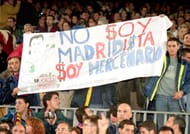
The 1999-2000 season was a poor one for Barcelona. Not only did the Catalans finish the season trophyless, they had to endure the indignity of watching their bitter rivals Real Madrid win the Champions League for the second time in three attempts despite finishing below them in the league, as well as see local foes Espanyol win the King’s Cup – the club’s first trophy for 60 years.
Patience with the unimaginative tactics and poor media relations acumen of manager Louis van Gaal had worn thin, and the Dutchman departed to much rejoicing in Catalonia. At the very least, though, Barcelona had Luis Figo, who was voted European Footballer of the Year for that season.
And then Figo left in July, for a huge transfer fee, and in the direction of the capital to become the first stroke on the canvas in Florentino Perez’s ambitious landscape for Real Madrid’s domination of the sport.
If the transfer was sensational, it was nothing compared to the reaction of the Barcelona fans. Figo returned to the Nou Camp on 22 October 2000, where he was greeted with a deluge of abuse and a hail of missiles – most eyebrow raising among them a few half-bricks, a bicycle chain, a number of coins and three mobile phones.
In the lead up to that game, thousands of fans took to creating several large copies of a 1,000 peseta note with Figo’s face and the phrase “Figo, money grabber” emblazoned on it in Spanish.
The sheer depth of the animosity was truly astounding. The Barcelona fans never forgave him, and the November 2002 derby at the Nou Camp ascended to even more mythical status than the “money grabber” encounter from two years previously.
This time, Figo had to dodge a full bottle of whisky and a pig’s head flung at him. Roberto Carlos took the Real Madrid players off in protest, and nasty accusations broke from Barcelona president Joan Gaspart following the match when he claimed Figo had been asked to take corners with the sole aim of provoking the home support.
#2 Michael Laudrup
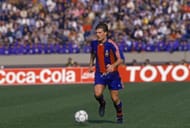
Michael Laudrup, now recognised as the well dressed, well travelled Dane, has a rather interesting story to tell from his playing days, co-starring, once again, the Barcelona faithful. Laudrup had signed for the club in 1989, envisioned as one of the architects behind the revolution instigated by manager Johan Cruyff upon his return to Catalonia for the first time since his days there as a player.
Laudrup settled in magnificently, and his elegant, stylish play was a key part of Barcelona’s capture of four consecutive Spanish league titles in the early 1990s, as well as the club’s first European Cup in 1992. It seemed a match made in heaven. Alas, the good times didn’t last.
Laudrup eventually fell out with the always-controversial Cruyff, implying through his angry words that Cruyff was jealous of Laudrup’s abilities as a player, and was deliberately holding him back so that Cruyff’s reputation as one of the best players in the history of Barcelona, as well as the sport, would remain intact. It was all extremely unsavoury.
Allegedly in an attempt to get one over on Cruyff, Laudrup moved to Real Madrid in 1994, and quickly formed a deadly partnership with the striker Ivan Zamorano on route to Madrid’s recapture of the league title in 1995. The Barcelona fans, however, were understandably not so keen as Cruyff to see the back of Laudrup.
The Dane, an affable, sophisticated character as well as a great footballer, received a response from the fans at the Nou Camp so mind-bendingly hostile, one would be forgiven for thinking he salted the earth of Catalonia in which the crops grew. He was booed, whistled at and vilified to the extent he looked visibly shocked and simply never got going on the pitch as a result. He quit Spanish football not one year later.
It did Barcelona little good, though. With Laudrup in the side, Real Madrid recorded a historic 5-0 win over their bitter foes in the title winning season.
#3 Luis Enrique
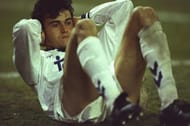
It seems astounding to the younger generation of fans that Luis Enrique was anything but a hardcore Barcelona loyalist. He served them with some distinction as a player and now as a manager, and it is difficult to imagine a more faithful supporter of the Catalan cause.
Yet he was always not so. It may come as a surprise that Enrique actually spent five personally fulfilling seasons at Real Madrid in the 1990s, winning one league title. His eventual departure eastwards was somewhat unexpected for someone who had been such an integral part of the side (over 200 appearances in all competitions over his five years), and to this day there is no one obvious reason as to why he left. Nevertheless, Barcelona were the beneficiaries, but Real Madrid had a special brand of hate reserved for him.
Unlike some of the other names on this list, Enrique seemed to enjoy being cast in the role of pantomime villain, and the intense hostility of the Real Madrid fans only seemed to egg him on further into a controversial gesture or spicy remark. It made for spectacle for the neutral, but the Madridistas were not amused.
Before his first reunion with Real Madrid in a Barcelona shirt, the newspaper Marca denounced him as a ‘traitor’ and ominously warned ‘we all know what happens to them’. The Madrid supporters booed him vociferously, and everytime he touched the ball, the choicest of filthy insults were flung his way.
The train did not stop. Enrique made a habit of scoring against his former employers, and added further fuel to fire by kissing the Barcelona badge on his shirt after he did so, or constantly stated he was happy in Barcelona, that the Real Madrid fans were unappreciative of his talent, that he had an unhappy time in the capital, or that the ideal situation is for Real Madrid to have ‘no points’ in the league.
The hate for Luis Enrique rose with each successive act of insolence, and there are many of them. The Madrid fraternity are aggrieved by each of them, and their palpable distaste for the former Sporting Gijon forward is no secret.
#4 Sol Campbell
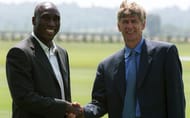
Amidst all the instability at Tottenham Hotspur in the 1990s, the fans could at least take solace in the one outstanding human rock in the tumult. Sol Campbell had, until a year and a half into the new millennium, been exactly the kind of player every fan can only wish their club had.
For Spurs, however, it was a reality. Campbell had risen from the youth ranks, making his senior debut in 1993. The following eight years saw him become the proverbial immovable object at the heart of the Spurs defence as well as the club captain. A local boy done proud, and there was no reason to suspect Campbell was anything but Spurs through and through.
Nevertheless, he entered the final 12 months of his contract in mid 2000, which made Spurs fans uneasy, but Campbell assured them he was going nowhere, least of all on a free transfer. Negotiations over a lucrative new contract broke down, however, and Campbell instead chose to sign for local rivals Arsenal in a deal that was perhaps the most earth-shattering in England since the transfer of Andy Cole from Newcastle to Manchester United some years previously.
It was unthinkable. Campbell had left a wound on the psyche of Spurs fans so unimaginably deep as to readily explain the amazingly hostile reception that followed. From 3 July 2001 onwards, Campbell became simply ‘Judas’ to many, and the hate, it seemed, was magnified by his phenomenal success at Arsenal.
In September 2008, a full seven years after the incident, by which time Campbell’s new club Portsmouth were hosting Tottenham, four Spurs fans were accused of directing racist and homophobic chants at the defender. They were eventually punished with a fine and a ban, but their behaviour suggests that the impact of Campbell’s transfer was far more serious than previously thought.
#5 Fernando Torres
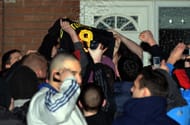
Of all the notorious transfers in football, this is perhaps most controversial and extreme of the past decade.
Although Fernando Torres had enjoyed a fast start to life in Liverpool on his 2007 transfer (33 goals in his maiden season; 24 of them in the league), and collected major international honours with Spain in the years that followed, he was, by early 2011, a spent force.
Serious injuries had reduced one of Europe’s deadliest hitmen to a pale shadow of his former self, and the decline was a truly sad one to watch for any football fan. Despite his waning influence, Torres was still an important part of a Liverpool side struggling massively in the 2010-11 season, before a Kenny Dalglish inspired late surge pushed them to a sixth place finish.
It is perhaps his status as one of Liverpool’s biggest transfer coups of the preceding ten years that made him an Anfield hero – and also made his eventual departure to Chelsea in January 2011 (for a then-record British transfer fee of £50 million) so painful.
The transfer to comparatively recent sparring partners Chelsea from Liverpool took place amidst astonishing scenes of fans burning replica Liverpool-era Torres jerseys. The striker was hotly booed and hounded by supporters when the two clubs met each other, most notably in Torres’ unhappy return to Anfield as Chelsea were demolished 4-1, and the 2012 FA Cup final.
Interestingly, Torres, by now playing for Atletico Madrid on loan from A.C. Milan, received a highly positive reception when he returned for a special charity game at Anfield in March 2015. Perhaps that suggests the Liverpool fans’ hostility was on account of Torres’ initial destination of choice in London, as opposed to the player himself.
#6 Robin van Persie

Among the many virtues of Arsene Wenger, somewhere near the top has to rank his persistence with players who would have been binned by other managers on account of frustration with their injury records, or for any other conceivable reason.
Robin van Persie is certainly one of those players. The possibility of his immense talent remaining forever subservient to his poor injury record was a very real one, but there was still a feeling that one of these seasons, the stars would align for van Persie and he would finally make the long overdue repayment of Wenger’s faith in him.
That was the 2011-12 season, and with Chelsea dropping out of the top four, and Liverpool some distance from it, the moment was Arsenal’s to grab, what with van Persie contributing a career-best 30 goals in the league that season. Unfortunately, however, it was not to be, and van Persie left for Manchester, with a much desired Premier League title in his future.
It seemed the Torres-shirt-burning stunt was in vogue. Van Persie’s replica jersey endured a similar fate, while his return to the Emirates (with Manchester United already confirmed as champions for 2013) provoked a predictably hostile response.
Fate, though, was tempted: Manchester United won a penalty, and van Persie stepped up to take with alongside riotous scenes of fans behind the goal using every possible trick to throw the striker off balance. It did little good. He scored, and Man United left London with a satisfactory point.
Van Persie’s is perhaps one of the tamer receptions on this list, but the little boy inside him might not agree.
#7 Roberto Baggio
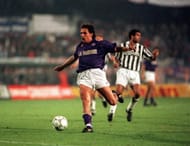
The case of Roberto Baggio is slightly different from the others on this list, but the nature of the reception of Fiorentina fans merits its inclusion on this list.
Baggio was, in 1990, the toast of Italy, never mind Florence. His prodigious skill, goal scoring capabilities and mental resolve (he had successfully recovered from a serious knee injury sustained while still a teenager) made him one of Fiorentina’s most valuable commodities.
The club itself, however, was desperately short of cash, and the president Flavio Pontello was more or less forced into handing over his most saleable asset to Juventus in exchange for a then world record fee of £8 million. Baggio did not want to leave. Judging by the reception to the news that followed, the Fiorentina fans didn’t want him to leave either.
On 19 May 1990, the transfer was confirmed and the city of Florence went into meltdown. Molotov cocktails, bricks and pieces of iron, chains and other projectiles populated the air even as Pontello was forced to take refuge in the club headquarters to avoid the worst of the riots that would, no doubt, have been directed in his general direction. 50 people were injured and nine others were arrested in the chaos.
Baggio? Ah yes, Baggio allegedly refused to wear the Juventus scarf during his official presentation, getting on the Old Lady’s fans’ wrong side from the off. And on 6 April 1991, he returned to his spiritual home at the Stadio Artemio Franchi to play Fiorentina in the famous black-and-white stripes of Juventus for the first time.
The response of the crowd was relentless. Baggio was booed for the length of the game, but, as football often has it, won a penalty in the second half with Juve trailing 1-0. Despite his well-known proficiency at that particular art, Baggio refused to take it, instead leaving the honours to Luigi De Agostini, but the latter saw his attempt saved by the Fiorentina goalkeeper Gianmatteo Mareggini. Juventus lost 1-0.
It got worse. Baggio picked up a stray Fiorentina scarf, presumably discarded by some angry supporter, and kissed it the moment he was substituted. It annoyed Juve fans enough for 300 of them to produce themselves at training two days later questioning his behaviour. Baggio could never convince either side. Damned if he did, damned if he didn’t.
